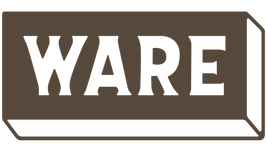
When a Solution isn't a Solution (read: isn't Sustainable)
As a seller of things who preaches that we should own less but better (my pitch for reading the book Essentialism), I often find myself in a predicament. With so many options available to consumers, a retailer’s biggest job is deciding what not to offer. That Ware is a sustainable lifestyle store eliminates, frankly, most products on the market. But even once you zoom in on just “sustainable” products, there are some more nuanced decisions that have to be made.
Sure, there are companies that are flat out greenwashing their marketing and claiming to be environmentally responsible and/or ethical when they, as a whole, are not at all. Those aren’t the hard decisions, once you figure out how to discern which brands are doing that. (I wish I had a shortcut or formula for that process, but the answer is lots of research and sometimes reaching out directly to the company.)
Keep the "usable" in reusable
The less obvious choices happen around functionality, I find. There is a growing category of reusable products that are intended to replace disposable, single-use products. There are the classics that are just being made cool again: water bottles, coffee cups, safety razors. There are the innovative solutions that replace disposable products of convenience and wasteful packaging: beeswax food wrap, solid shampoo, silicone food storage bags. And there are a variety of products that attempt to do one of the previously mentioned, but miss the mark, sometimes in more ways than one.
One such example, being made by a few different producers currently, is a product known as UNpaper towels. The idea is to have the convenience of a roll of paper towels on your counter, without the waste. Great idea, a washable, reusable textile that helps you keep the house clean... but it already exists. And it, you may have also concluded, is more commonly known as a rag (which we now sell, by popular demand). Some of these Unpaper Towels have snaps or velcro as ways of rolling them back onto paper towel rolls, so that they can sit out where their disposable counterparts once did. The Unpaper Towel is meant to look and act like the product we’re trying to eliminate. When that look is productive, great (like Stasher bags resembling plastic baggies), but when it actually complicates the process, it doesn’t create the eco-friendly product we’re looking for.
There’s also the fact that products used for cleaning get dirty. They take on the messes they remove and eventually look ugly themselves. That’s okay, because they keep our counters, floors, clothing, dishes, etc looking nicer longer. But it likely means there’s no need to display them and pretend they’re pleasant to look at.

In cases like this, reinventing the wheel is in and of itself quite wasteful, and therefore inherently unsustainable. Sometimes (often), it’s not the product that needs replacing, but the habits around it that will make an act less wasteful. Much of disposable culture is built around convenience, so we have to find ways of conveniently eliminating waste, if we want those habits to stick, not finding products that only half-fill the role (roll? hehe) they’re intended to. I have a rag system that I use in my kitchen in lieu of paper towels (see above). Eventually, I'll get it added to the blog. I shared the process in detail to our email list a few months ago, so get on our mailing list (at the bottom of the page), if these are the kinds of lifestyle hacks you’re into.
Unfortunately, (for the bottom lines of businesses who need to sell things to stay afloat) being true to the sustainable cause sometimes just means buying less and implementing less Instagrammable solutions that you likely have laying around your house already. If the “solution” to the problem doesn’t fully hit the target, it’s not, in fact, a solution.

Leave a comment